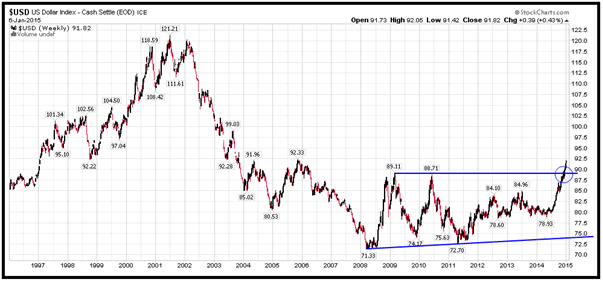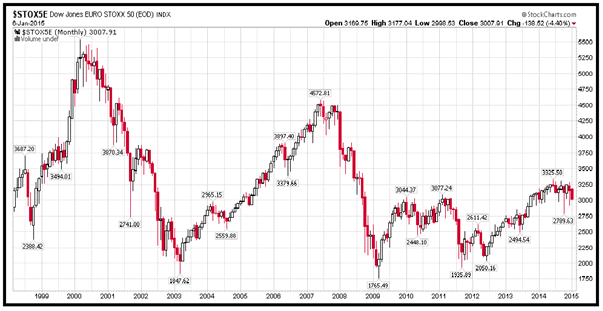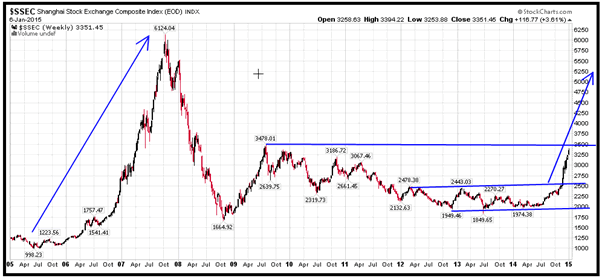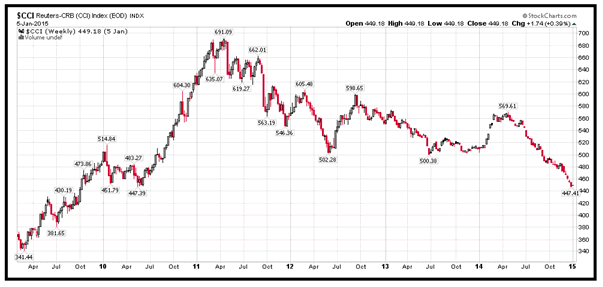Markets 2015 More Of The Same?
Stock-Markets / Financial Markets 2015 Jan 20, 2015 - 06:27 AM GMTBy: Puru_Saxena
 BIG PICTURE – During the previous year, the stock markets of the developed world consolidated whereas the majority of the developing nations performed poorly.
BIG PICTURE – During the previous year, the stock markets of the developed world consolidated whereas the majority of the developing nations performed poorly.
In 2014, the European stock markets essentially traded sideways, Japan produced modest growth and unsurprisingly, Wall Street delivered the best returns. Over in the developing world, the commodities producing nations (Brazil and Russia) fared badly, whereas China, India, Philippines and Thailand produced decent growth.
It is notable that over the past 12 months, a number of our expectations were met as the US Dollar strengthened, the Euro and Japanese Yen weakened considerably, stocks in the US did reasonably well, high yield bonds ended their epic bull run and commodities as well as precious metals took it on the chin! Finally, over in the emerging world, both of our preferred stock markets (China and India) did very well.
So, as we start this year, we wish to set out our expectations for the following 12 months.
Although there are no guarantees in the investment business, we are of the view that last year’s trends will probably continue over the following months, so you may want to remain over-weight stocks in the developed world. Elsewhere, we suspect that the US Dollar will continue to make headway against the majority of the world’s currencies and this will benefit American assets.
If you review Figure 1, you will note that the US Dollar Index has recently broken out of a huge trading range and climbed to a multi-year high! Usually, such breakouts are followed by explosive moves in the direction of the prevailing trend; so we should expect a big rally in the greenback. As you can see from Figure 1, at the turn of the millennium, the US Dollar Index topped out at 121.21 so at the current level (91.82), there is plenty of scope for additional gains.
Figure 1: US Dollar Index (weekly chart)

Source: www.stockcharts.com
If our assessment proves to be on the mark and the world’s reserve currency appreciates, it will drive capital to the US; thereby benefiting American bonds, real-estate and stocks. Furthermore, the ongoing strength in the American economy should also attract investors’ interest and this is why we recommend an over-weight position in the US.
Over in Europe, we suspect that at some point in the not too distant future, the ECB will unleash its own version of quantitative easing and this will drive up equities at the cost of the single currency. Remember, the European economy is still struggling and with the recent plunge in the price of oil, deflation has become a genuine threat. Thus, it is probable that the ECB will announce some form of ‘stimulus’ this year and it should benefit European stocks.
If you observe Figure 2, you will see that the Dow Jones Euro STOXX 50 Index is currently trading significantly below the highs recorded in 2000 and 2007; so there is sufficient upside potential for this recovery candidate. Should Mr. Draghi commence a wide scale bond buying program, European stocks will come to life. Accordingly, we recommend some exposure to this part of the world.
Figure 2: Dow Jones Euro STOXX 50 (monthly chart)

Source: www.stockcharts.com
Over in Asia, we continue to feel that the Japanese stock market will do reasonably well over the following months, so our readers may want to gain some exposure. After all, the Japanese policymakers are aggressively trying to stimulate the economy and this is driving up equities at the cost of the Japanese currency. Although we do not believe that Japan will regain its competitive edge anytime soon, we believe that quantitative easing will benefit local equities (especially, the exporters which become more competitive from a falling Japanese Yen). Thus, modest exposure to Japanese stocks is recommended.
In the emerging world, we are of the view that the commodity-producing nations will continue to suffer due to the ongoing primary downtrend in hard assets; so these stock markets may underperform over the following year.
Conversely, nations which are massive importers of oil will get tremendous assistance from the recent plunge in crude and their stock markets are likely to appreciate.
In terms of specifics, we believe that both China and India will benefit a great deal from the slide in the prices of commodities, so their stock markets should (once again) deliver good returns this year. It is worth noting that although India’s stock market has already appreciated by approximately 2½ times since the bear market low, China’s stock market (Shanghai Composite Index) has only recently come out of a 7-year bear market and it has appreciated by just 80% from the recent low! More importantly, the Shanghai Composite Index is still trading approximately 45% below its all-time high recorded in 2007; so there is lots of room for additional gains.
If you review Figure 3, you will see that the Shanghai Composite Index has just broken out of a 3-year trading range and once the 2009-high is overcome, we will probably get a big advance. Furthermore, you will observe that during the previous bull market, the Shanghai Composite went up approximately 600% in less than 3 years, so it is conceivable that we may also see some impressive fireworks in the current primary uptrend.
Figure 3: Shanghai Composite Index (weekly chart)

Source: www.stockcharts.com
China bulls may want to take heart from the fact that last month, investors on the mainland opened 2.7 million new stock trading accounts and since retail trading volume accounts for 80% of total transactions, this can only be seen as a positive development.
Although we do not possess a crystal ball, we believe that over the following months, we will witness an epic stock market mania in China! Similar to the last bull market, tens of millions of new trading accounts will probably open up and before it is all over, taxi drivers will proudly boast about their exploits in the stock market. Needless to say, when that happens, the bull market will be very mature and the painful end will be around the corner. Fortunately, we are still several months away from such a euphoric blow-off phase and in the meantime, there is a real opportunity to profit from China’s bull market.
Bearing in mind the above, we have allocated some capital to China’s A-Shares and over the past few weeks, these positions have produced a very good return. In the same vein, we suggest that our readers also consider getting some exposure to China’s domestic stock market.
Now that we have given you our outlook for the stock and currency markets, we want to briefly discuss the state of the commodities market. You will recall that we first turned bearish on the sector in late 2011 and since then, commodities have been in a persistent downtrend.
Even though prices have declined for almost 4 years, we suspect that we are only halfway through this primary downtrend. From our perspective, the macro-economic environment is not conducive to a sustainable bull market in commodities and this is primarily due to weak aggregate demand and ample supplies. More importantly, the US Dollar is in a primary uptrend and this should continue to weigh down on the commodities complex. After all, commodities are denominated in the world’s reserve currency, thus their prices are inversely correlated to the direction of the US Dollar. If the greenback continues to advance over the following months, this will probably create a significant headwind for commodities and precious metals. Accordingly, we believe that this is not the appropriate time to have any significant exposure to hard assets as the coming year will probably disappoint investors.
If you review Figure 4, you will note that last summer, the Reuters-CRB Index (CCI) sliced through an important area of support and by falling below the 500 level, it commenced another down leg in its primary bear market.
The CCI is currently trading at the same level as the 2010-low; so a near term bounce cannot be ruled out. However, the path of least resistance remains down and we are likely to witness further declines in the prices of commodities.
Figure 4: Reuters-CRB Index (weekly chart)

Source: www.stockcharts.com
In addition to commodities, we suspect that the prices of precious metals will also drift lower over the following year. Therefore, this may not be the best time to gain exposure to the metals.
Last but not least, as far as bonds are concerned, we are of the firm view that the high yield corporate bond market topped out last spring and we are now in the early stages of a lengthy bear market. Elsewhere, we believe that capital will continue to migrate towards US government bonds, so the ongoing rally will probably continue in 2015.
In summary, apart from the periodic counter-trend moves, we suspect that last year’s trends will continue this year, so our readers should refrain from swimming against the tide. For our part, we have allocated our managed portfolios to our preferred investment themes and it is our contention that these strategies will perform well this year.
Finally, in terms of sectors, we are seeing ongoing strength in the cyclicals (airlines, asset managers, auto parts, clothing, footwear, railways, retail and restaurants), therefore we have concentrated our equity portfolio in these areas.
Puru Saxena publishes Money Matters, a monthly economic report, which highlights extraordinary investment opportunities in all major markets. In addition to the monthly report, subscribers also receive “Weekly Updates” covering the recent market action. Money Matters is available by subscription from www.purusaxena.com.
Puru Saxena
Website – www.purusaxena.com
Puru Saxena is the founder of Puru Saxena Wealth Management, his Hong Kong based firm which manages investment portfolios for individuals and corporate clients. He is a highly showcased investment manager and a regular guest on CNN, BBC World, CNBC, Bloomberg, NDTV and various radio programs.
Copyright © 2005-2014 Puru Saxena Limited. All rights reserved.
Disclaimer: The above is a matter of opinion provided for general information purposes only and is not intended as investment advice. Information and analysis above are derived from sources and utilising methods believed to be reliable, but we cannot accept responsibility for any losses you may incur as a result of this analysis. Individuals should consult with their personal financial advisors.© 2005-2022 http://www.MarketOracle.co.uk - The Market Oracle is a FREE Daily Financial Markets Analysis & Forecasting online publication.



